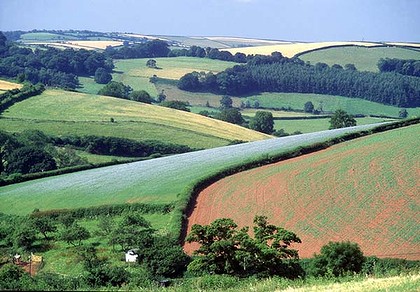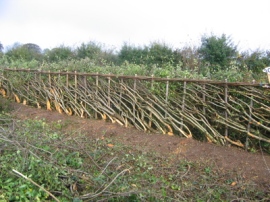The Fine and Bloody Art of Hedgerows
Posted by Richard Conniff on January 25, 2013
This is a piece I wrote in England in about 1994. It’s dated in terms of hedgerow destruction, and protection. (You can read an update here. And there are some additional links at the end of the article.) But I’m reprinting it on the hunch that some of the characters I met then are vanished types in the British countryside, and the crofters now probably all have iPhones.
“That’s a good hedge,” the farmer said, walking along a dense field border of hawthorn and beech, somewhere in the north of England. “It’s a grand habitat for things to creep in.” It was October, and the hawthorn were thick with bright red berries that songbirds would harvest over the winter. Here and there, a blackthorn was hung with fat, blue sloe berries. (“Three pounds of sloes, two pounds of sugar, and one bottle of gin,” said the farmer, giving his recipe for sloe gin. “I was telling a fella the other day that it’s three-two-one, and he said, ‘What, three bottles of gin?”) There were rosehips that moth caterpillars had mined out for sustenance, and others, still intact, that field mice would climb up to strip bare for seeds in the middle of February.
Britain’s hedgerows are, in truth, an excellent place for things to creep in, a long, thin bramble-and-thorn habitat. They are living fences populated by a Wind in the Willows community of moles, voles, badgers, weasels, and shrews. Roughly 60 bird species nest or feed in hedges, including white throats and black caps up from Africa for the summer, and redwings down for the winter from Scandinavia. So do hundreds of invertebrate species. Bats roost in tree hollows by day and cruise the hedgerows for dinner by night. Hedgehogs, despite their name, generally prefer household gardens. But hedge sparrows are commonplace in hedges, making mossy nests full of beautiful pale blue eggs. Indeed, for many species, hedges are the only available habitat.
“There is no natural habitat left in the United Kingdom,” says Colin Barr, who oversees a nationwide “countryside survey” for the Institute of Terrestrial Ecology. “There is some semi-natural habitat, meaning little or no current interference by man–for instance, the sub-arctic plateau in Scotland.” But the forests in many upland areas are actually government-sponsored plantations–often little more than tree farms. And in the intensively-farmed lowlands, hedges and a few stream borders are the only habitat–indeed, often the only vegetation that hasn’t been plowed flat. “So it follows,” says Barr, “that hedges are seen as particularly important.”
But hedgerows have always been a sort of shadow habitat, a habitat almost by accident. They existed in the first place because farmers needed them, perhaps as far back as the Bronze Age more than 5000 years ago, to separate and shelter their livestock. Hedgerows divided the countryside into a patchwork of small fields, creating a landscape that the poet Andrew Marvell once called “the garden of the world.” But when farmers no longer needed the hedgerows, in the decades after World War II, they began to disappear. Intensive modern agriculture enabled many farmers to replace pastures with crops, and large agricultural machinery made small hedged fields impractical. Even on farms that stayed with livestock, barbed wire was cheaper and required less labor than keeping up a hedge. So where there were 500,000 miles of hedgerow in the mid-1940s, only 240,000 miles (400,000 km) survive today. Until the late 1980s, the government actually paid farmers a subsidy to tear out their hedges.
You can see the results all over the modern British countryside. Driving through the Midlands, you pass hedges that have gone gappy and toothless with neglect, and others that have grown up into a scraggly row of trees. Elsewhere, the fields run for miles without hedges and the crops are separated from the traffic by just five feet of grass. The rolling, unbroken fields, the post-and-barbed wire fences, the radio towers blinking, could just as easily be in Iowa as in England. The neatly cropped, carefully tended hedgerows that were once the bones and marrow of the British landscape have largely vanished.
With the decline in hedges, farmland birds have also decreased in number and range, among them the grey partridge, song thrush, linnet, bullfinch, and corn bunting. Even where hedges survive, the methods now used to maintain them can sometimes reduce their value to wildlife. A butterfly named the brown hairstreak, for instance, comes out late in the autumn, and lays its white eggs in the new growth of blackthorn shrubs. But landowners often root out blackthorn from their hedges because it tends to colonize adjacent fields. And when modern farmers trim a hedge every other year or so, they generally use a tractor attachment called a flail, a sort of airborne rotary lawnmower. The flail takes out most new growth, and the butterfly eggs with it. Despite conservation efforts by volunteer groups around England, the brown hairstreak has suffered a dramatic decline. It’s an unspectacular butterfly with a two-inch wingspan, “a medium brown job,” says an entomologist. But it’s also a piece of the ecosystem, no more, no less, and no one really knows what other species are affected by its disappearance.
“It’s hard to pinpoint species which are totally dependent on hedges,” says Nigel Boatman of the Game Conservancy. Only one species, a plant called the plymouth pear, is reportedly found only in hedges. Most plants and wildlife have evolved in woodland or scrub habitat, then shifted to hedgerows when their native habitat disappeared. But Boatman adds that the continuing disappearance of hedges could considerably reduce numbers of some species and fragment the remaining population. “This could lead to extinction, especially for species which are already local in distribution.”
The value of hedges as a wildlife resource and as a part of the national heritage is now widely accepted in Britain–though not necessarily protected. “In Cambridgeshire, I know of a particularly lovely hedge, called Judith’s Hedge, that is older than Salisbury Cathedral … older than all but a handful of buildings in Britain,” Bill Bryson writes in his book, Notes from a Small Island. The hedge was planted at the behest of William the Conqueror’s niece, for whom it is named. Bryson laments that no law exists to protect such hedges from road-widening schemes or the whim of some brainless owner, who could “bulldoze away 900 years of living history” in a couple of hours.
In fact, Britain’s department of the environment is currently developing just such a law, so that farmers would have to seek permission to remove a designated hedge, much as they might for a historic building. But so many hedges would be protected under the proposed criteria of age, diversity, or as corridors to woodlands, that farmers would have rioted. So the agency is now seeking to develop new criteria that would protect, at most, 8 or 10 percent of all hedges.
As a more palatable way of getting farmers to value their hedges, the government in 1989 reversed its old policy and now pays subsidies for planting and maintaining hedges. As a result, more miles of new hedgerow get planted each year than get pulled out. But the Institute for Terrestrial Ecology estimates that Britain still suffers a net loss of about 11,000 miles of hedgerow each year, because of neglect.
When you see what maintaining hedges actually involves, you begin to understand why farmers neglect them. In addition to regular trimming,, a hedge also needs to be cut down almost to ground level every 15 or 20 years. The old growth remains attached to the root by a thin strap of bark, and gets laid over parallel to the ground along the length of the hedge and woven into a thick living fence. But the skilled field hands who used to do the hedge-laying have mostly departed from the countryside, replaced by machinery.
A few traditionalists keep the art of hedging alive, especially in hilly, less developed areas like Wales and the southwest of England. Each region has its own style of hedging, and also its own language: The tall, wrist-thick shoots that get cut halfway through and laid over horizontally are called “liggans” in one part of England, and “splashers” in another. The stakes that get driven in to hold the laid-over shoots together are called “stakes” in some places and “stabbers” in others. Some areas plant their stakes on alternate sides of the hedge, others drive them into the middle and braid them together with vines, so a cow can’t get her nose under and life the whole hedge into the air. Each region’s hedgers naturally regard their own technique as best, and mildly disparage alternatives. “It doesn’t look right,” they say, and then they add some diplomatic phrase like, “You can understand why they do it,” by which they generally mean the opposite.
But the basic approach to hedging is the same everywhere. First, the hedger clears out the brambles, deadwood, and other undesirables, leaving only healthy hardwood, which is mostly hawthorn. “When you get your thorn,” said Chuck Mason, a dairy farmer in Cumbria, using the local term for the upright shoot, “you cut in at an angle, and it splits down into the ground.” A thin piece of living tissue remains intact to feed the shoot after it is laid over, so it will continue to produce new growth. “Your new shoots come up from ground level. You don’t want ’em coming from a foot or so in the air, or your sheep and little lambs will dart under.” A shaggy, overgrown hedge perhaps 15 feet high ends up as a thickly-woven waist-high fence. It is almost the exact technique described by Julius Caesar, who encountered hedges on the French-Belgian border 2000 years ago and wrote that they were “impossible to penetrate.” He thought the local tribesmen erected them primarily to discourage the neighbors from looting and pillaging.
Even if the intent is peaceable, hedging often involves bloodshed. “These want to bite,” said Frank Wear, indicating the sharp thorns in a typical hedge. “You’re bound to get a cut of some description. You’re bound to see blood flyin’, and you ignore that. Everybody gets cut.”
Wear is chairman of the Wrington and Burrington Hedging Society in Somerset, a group of West Country crofters like himself devoted to preserving old methods. (“You know what a crofter is?” he asked. “Keeps a few old hens and a few old cows and loses money, that’s a crofter.”) He has been hedging for somewhere over 50 years. (I’m as old as my little finger,” he said, “but a bit older than me teeth.”) When Jon Marshall, a hedge ecologist at Bristol University’s Long Ashton research station, first approached him, Wear said he was not enough of an expert to talk about hedging. But he agreed to meet in the capacity of country bumpkin. (“I can do that,” he said.) He showed Marshall the tools of his trade–a long-handled staff hook, or slasher, for trimming high foliage, a reap hook, like a sickle, for cutting grass and briars in front of the hedge, a variety of billhooks, like short, curved machetes, and a small axe.
“The art of hedging is a lot like anything else,” he said, “you must have sharp tools and nice thick gloves.” He held up a heavy leather mitten for the left hand. “It’ll take a helluva bash with the hook,” he said. But the salvation of modern hedging, he added, is the chainsaw. He showed us a foot-thick hawthorn tree that he had cut with a chainsaw and laid over into a hedge, cutting it again three more times along its fifteen-foot length, to keep it low to the ground, all in a matter of minutes. “When you had to cut something like that with an ax,” he said, “it did try your system for a day or two.”
Wear’s career with the hedging society reflects the revival of British interest in hedges. When he took over in the mid-1970’s, the few remaining members of the society were ready to give it up, but Wear persuaded them to hang on for a year or two until they’d held their 150th annual competition, “and then we’ll bloody well make it or break it.” The hedge-laying competition soon began to make money, attracting newcomers interested in hedges as wildlife havens and as features of the traditional landscape. Wear now teaches a hedging course not just for farmers’ sons, but for accountants and bank managers who’ve bought a house in the country. “Some of them don’t know the difference between a thorn and a briar,” he complains. The first day I say, ‘It’s a pity your mother never drowned you.’ I say that the first day, and they get used to me.” Some students are only interested in learning how to lay the hedge in their back garden, but others wade into the bloody fray of the hedging competitions, in which each competitor lays 11 yards of hedge over five hours, for a first prize of about $40. “One woman came with her lipstick on and her nails varnished and, bugger me if she didn’t win. Beat 20 blokes.”
Marshall asked him how he judged a hedging job. “The cuttin’. A nice clean cut,” said Wear. “The run of the hedge, keeping it all on the same angle. The briars and the holly and all the rubbish out. What we call staking–the stakes down through it. You always make a fence so the sheep can’t get underneath. Because a hedge will always grow up, it’ll never grow down.”
Wear in turn questioned Marshall about the agricultural advantages and disadvantages of different hedge types. Back when the hedges were all being grubbed out, farmers typically regarded them not merely as an impediment to tractors, but as a haven for weeds and insect pests. Marshall’s research helped him to allay these fears. The most common hedge plants are hardwood perennials poorly adapted for colonizing nearby fields, said Marshall. A handful of annuals around hedges can contribute to weed problems, especially if a farmer cultivates right to the edge of the field and sprays herbicides around the hedge base. But if, instead, the farmer simply leaves a thin grassy border along the edge, then what Marshall calls “plant nasties” have no place to germinate. The natural border also becomes an attractive breeding site for game birds like pheasant and partridge, an important source of winter income for many farmers.
Hedges do harbor insect pests like aphids, Marshall said. These pests adapt quickly to any threat, and they are inevitably one step ahead of the farmer’s chemical control methods. But researchers have noticed that hedges are also home to an army of beneficial insects, including predatory beetles and parasitoid wasps, said Marshall. The idea in “integrated pest management,” which is drawing increased interest among farmers, is to reduce levels of pesticide and use the hedges to supply a pest’s natural enemies, Aphids, for instance, are miraculously well adapted to attack a new crop. They practice parthenogenesis–literally virgin birth, without mating–and their offspring, born live, already contain the next generation of offspring developing within them, like Russian dolls. They can produce a new generation every two or three days. But a parasitoid wasp in the hedge is capable of attacking the aphids early in the spring, when each aphid killed eliminates “whole future sections of the population.” Marshall showed Wear a hedge where a colleague has hung traps to find out what kinds of insects overwinter in the hedge, and which type of hedge management works best for beneficial insects. Fields of crops are ecologically unstable, he said, and they may need the semi-natural area of the hedge as a balance. In one German study, the most productive farm was one with hedgerows at roughly 100-yard intervals–precisely the “garden of the world” landscape that farmers diligently maintained in the unenlightened past.
Wear and Marshall drove home along a winding road, where the hedges joined to form a tunnel overhead and you could reach out either window of the car and get bitten by hawthorn. Marshall wondered why the old hedges are so seldom straight: “When they planted the hedges they got paid by the yard,” Wear joked, “and they made them crooked to get more yards in.”
It was surely not the fastest road for getting from one place to another, nor was it the sort of landscape preferred by modern industrial farmers with big tractors and a blinkered, bottom line worldview. Hedgerows are an inconvenience in the get-ahead world of modern Britain. But they are unmistakably British. And it isn’t just a way of life, or a vast community of wildlife that depends on the preservation of the hedgerows, Marshall suggested, but perhaps ultimately the survival of the farmers themselves.
END
For more current information, here’s a link to the English Hedgerow Trust and one to the British National Hedgelaying Society
This entry was posted on January 25, 2013 at 3:26 am and is filed under Biodiversity, Conservation and Extinction, Cool Tools, Environmental Issues. Tagged: hedge laying, hedgerows. You can follow any responses to this entry through the RSS 2.0 feed. You can leave a response, or trackback from your own site.








Gillian McDonald said
Hi Richard, the Crofter mentioned (Frank Wear) is now 86 years old and no doesn’t have a mobile phone let alone an ipad/phone. I am his daughter reading this in Australia.
LikeLike
Richard Conniff said
Excellent news. He’s a character. Hope he is still hedge-laying. Thank you, Gillian.
LikeLike
Gillian McDonald. said
Hi Richard, no my Father isn’t hedge laying at the moment due to ill health. Recently he received an award from Prince Charles for his services to hedging. I am sending you some photos via email. Cheers Gill McDonald.
LikeLike